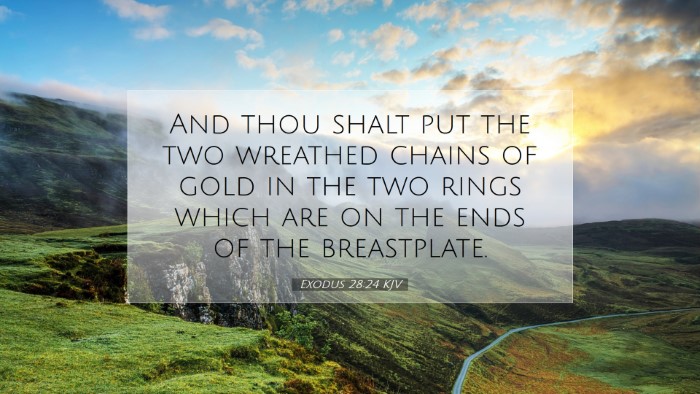Commentary on Exodus 28:24
Exodus 28:24 states: “And thou shalt put the two chains of gold in the two rings which are on the ends of the breastplate.” This verse is part of the larger context that revolves around the priestly garments, specifically the breastplate of judgment, which was to be worn by the High Priest, Aaron.
Historical Context
This passage is set in the book of Exodus, which narrates the Israelites' journey from slavery in Egypt to the Promised Land. Here, God is giving specific instructions regarding the tabernacle and the priesthood, highlighting the holiness required in approaching Him. The garments described are not just for adornment, but are filled with spiritual symbolism.
The Significance of the Breastplate
The breastplate of judgment, capable of holding the Urim and Thummim, was designed to reflect God's will in decision-making. It symbolized the responsibility and burden of leadership in spiritual matters. The chains of gold serve both a practical and symbolic purpose in this context.
Chains of Gold
The directive to use chains of gold reinforces several significant ideas:
- Value of Holiness: Gold represents purity and value; thus, using gold signifies the high regard for the holiness of God’s presence.
- Connection of the People: The breastplate, with its stones representing the twelve tribes of Israel, is held in a prominent place. The gold chains ensure that Israel's representation before God remains secure and connected to His judgment.
Theological Implications
This verse reflects theological principles that are vital for understanding God's desire for His people:
- Access to God: The priesthood, as exhibited through the High Priest's garments, indicates a divine access that we now understand through Christ’s mediation.
- The Weight of Leadership: This verse serves as a reminder that leaders in the church today are called to bear the burdens of their congregations, representing them before God.
Commentary Insights
Matthew Henry's Perspective
Matthew Henry observes that the breastplate serves not only a functional purpose but emphatically asserts the dignity of the High Priest's office. He notes that the intricacies of its design illustrate the gravity with which spiritual matters must be treated. Henry draws attention to the imagery of the gold chains, highlighting that they portray strength and beauty, reinforcing the significance of divine guidance.
Albert Barnes' Interpretation
Albert Barnes elaborates on the construction processes and the meticulous attention given to the details of the priestly garments. He suggests that the chains symbolize the binding nature of God's covenant with His people, indicating that they are closely tied to the divine will. According to Barnes, the priest’s role is not only one of intercession but also one of maintaining a connection to the community that he represents.
Adam Clarke's Observations
Adam Clarke expands upon the materials used, examining the socio-cultural significance of gold and its association with the divine. He details that the chains serve as a reminder of the connection between the High Priest and his service, suggesting that they signify the "wisdom and judgment" that should guide those who take on such leadership roles. Clarke emphasizes that the breastplate being fastened securely indicates the stability that God desires in the priesthood.
Practical Applications
The principles found in Exodus 28:24 can be applied in various ways:
- Leadership Integrity: Current church leaders must maintain a commitment to purity and the weight of their office, reflecting the holiness of the duty they embrace.
- Commitment to God: Just as the chains anchor the breastplate, so our faith must be anchored in a relationship with God, ensuring the direction of our lives aligns with His will.
- Community Representation: Pastors and leaders today are called to represent their congregations before God, understanding the shared responsibility to bear one another's burdens in prayer.
Conclusion
Exodus 28:24 encapsulates profound insights into the nature of God's design for leadership, the importance of holiness, and the connection between the divine and His people. The gold chains holding the breastplate signify that high and holy calling, a reminder of the value God places on His relationship with His chosen ones. Through exploring historical records and scholarly insights, we deepen our understanding of this crucial scripture, inviting us to reflect on our own roles as representatives before God.


